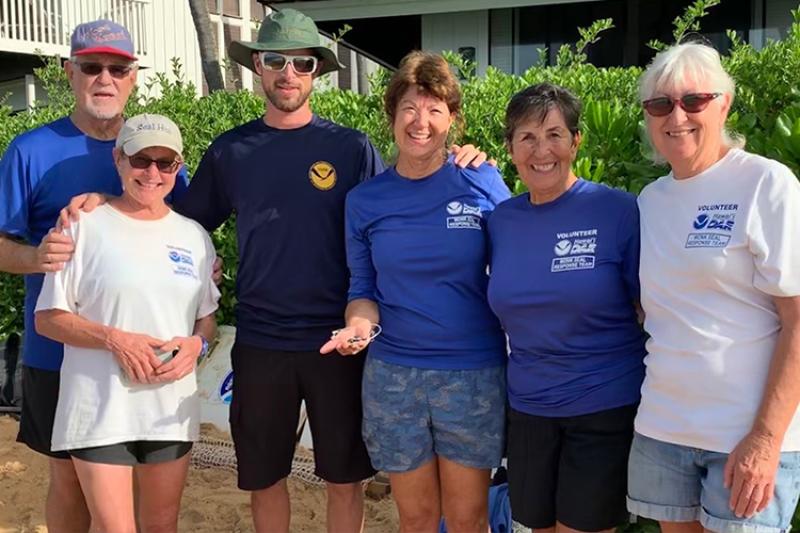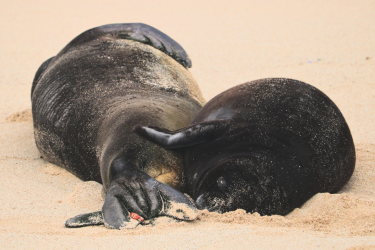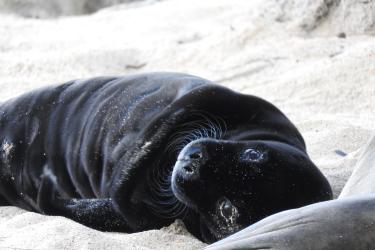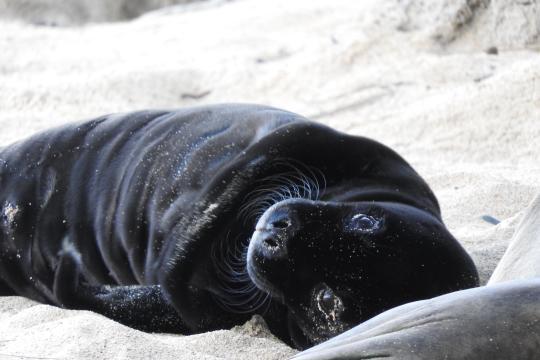If you’ve encountered a monk seal on one of the beaches of Hawai‘i in the last 10 or 15 years, it’s likely that seal was accompanied by signage, possibly some ropes, and a volunteer full of fun facts about monk seals. You may have also seen volunteers assisting with crowd control when a monk seal strands, at a community event booth, or in your child’s classroom. We thought we’d shift the spotlight from the seals to the volunteers for a moment—here is a little bit about who these dedicated individuals are and the amazing work they do for monk seals and the community.
Who Ya Gonna Call?
Have you ever called in a sighting or stranding of a monk seal to the NOAA Marine Wildlife Hotline (888-256-9840)? If so, you reached NOAA Fisheries or one of several NOAA grant–funded organizations that manage monk seal volunteers in Hawai‘i.
The hotline is set up for taking in information on a variety of protected marine species. You can call the hotline from anywhere in the state to report monk seal sightings, as well as stranded or injured monk seals, whales, dolphins, and sea turtles. You can also call to report stranded or injured seabirds on O‘ahu. The hotline operators are directly involved in animal monitoring and stranding response.
Different organizations manage the volunteers on each island, but the work they do is much the same. When O‘ahu or Moloka‘i answers your call, you will be talking with an operator from Hawaii Marine Animal Response. The Marine Mammal Center runs the Hawai’i Island and Maui volunteer programs, as well as Ke Kai Ola, the hospital for monk seals in Hilo. All of these organizations collect data, disseminate information, and conduct responses in close coordination with permitted NOAA officials.
Hotline operators collect and verify as much information from callers as possible. This allows us to have confidence when determining the identification (usually from natural markings, applied bleach marks, or flipper tags) and condition of the seal you've sighted. It also helps us determine what type of response—if any—is appropriate. Whether you can identify every seal on your island or you don't know a monk seal from a harbor seal, the hotline operator is going to ask you multiple questions. Don’t worry, it's ok if you don't know all of the answers! And if you do know all the answers, we appreciate your patience as the operator asks a series of important questions that may seem obvious to you. This process is the same whether this is your first time reporting or you're a dedicated monk seal watcher who has called the hotline dozens of times. Each of these organizations employs staff members who also perform these activities, and who are just as dedicated to monk seal conservation as the volunteers.
What Else Do Volunteers Do?
Volunteers Do Set Up Seal Resting Areas
Seal resting areas (SRAs) are small areas of shoreline around hauled-out monk seals that are temporarily delineated with signs, rope, and/or fencing. Volunteers use SRAs primarily to conduct on-scene outreach to:
- Inform the public that a monk seal is resting in the area
- Promote informed public decisions and actions around monk seals
- Enhance public safety
Trained volunteers managing an SRA reinforce responsible wildlife viewing and the concept of respectful coexistence, while providing beachgoers with valuable monk seal conservation and life history facts. SRAs are just one tool to help limit human-seal interactions and prevent habituation to human presence. The ultimate goal is consistent and widespread public outreach. Hopefully, SRAs eventually become unnecessary as the vast majority of beachgoers will know how to coexist with monk seals.
Volunteers Do Conduct Education and Outreach
The growth of the monk seal and human populations in the main Hawaiian Islands led to an increasingly large number of people in contact with monk seals. Education and outreach efforts encourage responsible behavior around monk seals. These efforts increase both residents’ and visitors’ understanding of the important role monk seals play in the islands’ marine ecosystem. This ensures the greatest possibility for peaceful coexistence between seals and people. Volunteers also share information about the variety of threats that monk seals face—from fisheries interactions to the deadly cat-borne disease toxoplasmosis—and actions people can take to help address those threats.
Volunteers Do Assist with Responses and Monitor Seals of Concern
Sick or injured monk seals don’t always cooperate and stay in one place until help arrives. Volunteers may perform searches for seals in need of assistance. They may also keep an extra close eye on seals with minor injuries that don’t need immediate attention but have the potential to become more serious.
When a response does take place, it sometimes requires a lot of help! Trained volunteers assist with responses by:
- Performing crowd control
- Explaining to the public what’s happening
- Assisting with capture
- Providing rehabilitative care (in the case of Ke Kai Ola)
We’re always especially interested to see how seals that receive medical treatment are doing after they are released. Volunteers try to closely monitor those animals—even if they are equipped with satellite tags—to make sure they are reacclimating to the wild.
Volunteers Do Assist with Other Conservation Activities
Many of the volunteer organizations in Hawai‘i focus on multiple marine species. For example, some might respond to entangled turtles, assist with cetacean strandings, or monitor seabird nests. Volunteer organizations may perform beach clean ups, marine debris removal, and shoreline restoration to benefit the marine ecosystems and wildlife of Hawai‘i. Their education and outreach programs often encompass facts and conservation messages about multiple species and ecosystems.
What Don’t Volunteers Do?
Volunteers Don't Enforce the Law
While disturbing or harassing a monk seal is illegal under federal and state law, volunteers are not out on the beaches to enforce those laws. They are there to provide information about monk seals and helpful suggestions for responsible behavior. For example, volunteers can remind members of the public that dogs must be leashed on certain beaches, especially near seals. However, they cannot issue citations for having an unleashed dog.
It’s important to note that the SRAs the volunteers set up are not legal boundaries. Instead, they are meant to alert the public to the presence of seals and help people avoid inadvertently disturbing them.
If volunteers observe actions that are potential violations of the law, they call it into the proper authorities—NOAA Office of Law Enforcement or DLNR Division of Conservation and Resources Enforcement—just like a member of the public would. We know it can sometimes be frustrating to have to wait for the authorities, but it’s safest for everyone involved. And keep in mind: A poor interaction with a well-intentioned volunteer attempting to play the role of law enforcement could leave members of the public with a negative view toward seals. This could be counterproductive for monk seal conservation.
Volunteers Don't Respond in Person to Every Seal Sighting, or Set Up an SRA Around Every Seal
The level of on-site outreach that volunteers provide varies depending on several circumstances. There may be other agencies, businesses, community groups, or members of the public who act as stewards of certain beach areas and keep an eye on resting seals. This could reduce or negate the need for a volunteer response.
There is a misperception that SRAs limit public access routes to beaches. To help avoid perpetuating this view, volunteers may sometimes not set up an SRA if there is no immediate risk to the seal or beachgoers. An SRA may also not be necessary if a seal is in a remote location where there are few to no people, or where there is a natural or manmade boundary between high public use areas and the seal. Whether an SRA is needed or not, keep calling in monk seal sightings to the hotline! Whether the seal is on the beach or in the water, every monk seal sighting report provides us with important information on these seals that inform conservation efforts:
- How many seals there are
- Where they are, how they use habitat
- How they move within and between islands
- How they interact with people and with each other
Volunteers Don't Make Decisions or Diagnoses When it Comes to Animal Health and Welfare
NOAA Fisheries’ qualified biologists and veterinarians are the decision-makers when it comes to when and how to respond to a sick or injured seal. These activities are conducted under specific permits. Volunteers are sometimes put in the difficult position of having to explain to the public why we made a certain decision, such as leaving an external hook in place. Monk seals have a remarkable capacity to heal, and we often choose not to intervene in the case of non-life-threatening injuries. This helps avoid the stress and other risks that accompany capture and handling of an animal, and averts potential risks to responders’ health and safety.
It is important to bear in mind that, while unfortunate incidents can and do occur, monk seals are large, wild animals that are capable of fending for themselves in most circumstances. Volunteers are not there to physically “protect” seals. Instead, their role is to share knowledge about monk seals and help foster the idea of “informed coexistence” with humans, which is to keep people safe and seals safe and wild.
Interested in Becoming a Volunteer?
If being a monk seal volunteer sounds like something you’d be interested in, see how you might be able to get involved on your island. Volunteers are a critical part of monk seal recovery efforts, and we are extremely grateful for their hard work and dedication to conserving our state’s native seal!














